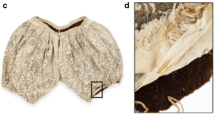Abstract
Silks represent some of the most precious ancient and historic textile artefacts in collections worldwide. Their optimum preservation demands an appreciation of their characteristics. One important concern, especially with regard to ancient Chinese silks, is whether the fabrics have been degummed. Silks with remnant sericin gum coating the fibroin fibres would require different conservation protocol. In previous research on aged silks, the presence of sericin has been inferred from amino acid analysis of hydrolysates. In the study reported here, the potential of FTIR spectroscopy to provide a simpler and rapid method of detecting sericin on silk has been investigated. Both fibroin and sericin exhibit singular IR absorptions. Attenuated total reflectance spectroscopy was found to highlight the sericin coating more effectively than transmission and reflectance spectroscopy. Three particular peak intensity ratios were identified which might provide a quantitative estimate of the sericin content of new silk, to a sensitivity of 1%–2%. These were also shown to be valid indicators for the presence of sericin on artificially aged and archaeological silks, although quantitation was now not possible. Besides the peak intensity ratios, two signature peaks were also seen to be useful markers for silk fibroin, and their presence in a spectrum could be used to infer a degummed silk.
Similar content being viewed by others
References
Vanden BI, Wouters J. Identification and Condition Evaluation of Deteriorated Protein Fibres at the Sub-Microgram Level by Calibrated Aminoacid Analysis, In: Postprints First Annual Conference of the AHRC Research Centre for Textile Conservation and Textile Studies, Scientific Analysis of Ancient and Historic Textiles: Informing Preservation, Display and Interpretation, Winchester, 13–15 July 2004. Eds. Janaway R and Wyeth P, London: Archetype, 2005. 151–158
Peng H. Textile and Apparel of Chu Dynasty (in Chinese). Wuhan: Hubei Education Press, 1996. 32
Becker MA, Willman P, Tuross NC. The US First ladies gowns: A biochemical study of silk preservation. J Am Inst Conservati, 1995, 34: 141–152
Nimmen E, Clerck K, Werschuren J, Gellynck K, Gheysens T, Mertens J, Langenhove L. FT-IR spectroscopy of spider and silkworm silks Part I. Different sampling techniques. Vib Spectrosc, 2008, 46: 63
Garside P, Wyeth P. Identification of cellulosic fibres by FTIR spectroscopy I: Thread and single fibre analysis by attenuated total reflectance. Studies in Conservation, 2003, 48: 269–275
Chen DJ. Chemistry in Silk Making (in Chinese). Beijing: China Textile and Apparel Press, 1995. 11
Arai T, Freddi G, Innocenti R, Tsukada M. Biodegradation of Bombyx mori silk fibroin fibers and films. J Applied Polymer Science, 2004, 91: 2383–2390
Calvini P, Vassallo S. Computer-assisted infrared analysis of heterogeneous works of art. e-Preservation Science, 2007, 4: 13–17
Author information
Authors and Affiliations
Corresponding author
Rights and permissions
About this article
Cite this article
Zhang, X., Wyeth, P. Using FTIR spectroscopy to detect sericin on historic silk. Sci. China Chem. 53, 626–631 (2010). https://doi.org/10.1007/s11426-010-0050-y
Received:
Accepted:
Published:
Issue Date:
DOI: https://doi.org/10.1007/s11426-010-0050-y




